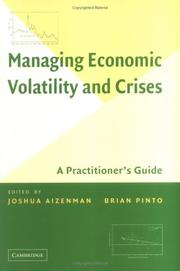| Listing 1 - 10 of 42 | << page >> |
Sort by
|
Book
ISBN: 0191782971 Year: 2014 Publisher: Oxford : Oxford University Press,
Abstract | Keywords | Export | Availability | Bookmark
 Loading...
Loading...Choose an application
- Reference Manager
- EndNote
- RefWorks (Direct export to RefWorks)
This text shows how to think about economic growth and sovereign debt in live country situations. The country stories are practical applications of real-time analysis involving significant economic events of the past two decades (e.g. Poland's early transition, India's unexpected growth takeoff in 2003, and the Russian crisis of 1998).
Economic development --- Development economics --- Business & Economics --- Economic Theory

ISBN: 9780511510755 9780521855242 9780521168595 0521855241 9780511139031 0511139039 0511140347 9780511140341 0511138288 9780511138287 0511140037 9780511140037 9780511140808 0511140800 9786610309030 6610309035 0511510756 0521168597 1107155290 1280309032 0511301006 9781107155299 9781280309038 9780511301001 Year: 2005 Publisher: Cambridge New York Cambridge University Press
Abstract | Keywords | Export | Availability | Bookmark
 Loading...
Loading...Choose an application
- Reference Manager
- EndNote
- RefWorks (Direct export to RefWorks)
Economic volatility has come into its own after being treated for decades as a secondary phenomenon in the business cycle literature. This evolution has been driven by the recognition that non-linearities, long buried by the economist's penchant for linearity, magnify the negative effects of volatility on long-run growth and inequality, especially in poor countries. This collection organizes empirical and policy results for economists and development policy practitioners into four parts: basic features, including the impact of volatility on growth and poverty; commodity price volatility; the financial sector's dual role as an absorber and amplifier of shocks; and the management and prevention of macroeconomic crises. The latter section includes a cross-country study, case studies on Argentina and Russia, and lessons from the debt default episodes of the 1980s and 1990s.
Business cycles. --- Financial crises. --- Economic development. --- Development, Economic --- Economic growth --- Growth, Economic --- Economic policy --- Economics --- Statics and dynamics (Social sciences) --- Development economics --- Resource curse --- Crashes, Financial --- Crises, Financial --- Financial crashes --- Financial panics --- Panics (Finance) --- Stock exchange crashes --- Stock market panics --- Crises --- Economic cycles --- Economic fluctuations --- Cycles --- Business, Economy and Management
Digital
Abstract | Keywords | Export | Availability | Bookmark
 Loading...
Loading...Choose an application
- Reference Manager
- EndNote
- RefWorks (Direct export to RefWorks)
Digital
Abstract | Keywords | Export | Availability | Bookmark
 Loading...
Loading...Choose an application
- Reference Manager
- EndNote
- RefWorks (Direct export to RefWorks)
Digital
Abstract | Keywords | Export | Availability | Bookmark
 Loading...
Loading...Choose an application
- Reference Manager
- EndNote
- RefWorks (Direct export to RefWorks)

ISBN: 082132974X Year: 1994 Publisher: Washington, D.C. World Bank
Abstract | Keywords | Export | Availability | Bookmark
 Loading...
Loading...Choose an application
- Reference Manager
- EndNote
- RefWorks (Direct export to RefWorks)
Book
Abstract | Keywords | Export | Availability | Bookmark
 Loading...
Loading...Choose an application
- Reference Manager
- EndNote
- RefWorks (Direct export to RefWorks)
Russia had more-or-less completed the privatization of its manufacturing and natural resource sectors by the end of 1997. And in February 1998, the annual inflation rate at last dipped into the single digits. Privatization should have helped with stronger micro-foundations for growth. The conquest of inflation should have cemented macroeconomic credibility, lowered real interest rates, and spurred investment. Instead, Russia suffered a massive public debt-exchange rate-banking crisis just six months later, in August 1998. In showing how this turn of events unfolded, the authors focus on the interaction among Russia's deteriorating fiscal fundamentals, its weak micro-foundations of growth and financial globalization. They argue that the expectation of a large official bailout in the final 10 weeks before the meltdown played an important role, with Russia's external debt increasing by USD 16 billion or 8 percent of post-crisis gross domestic product during this time. The lessons and insights extracted from the 1998 Russian crisis are of general applicability, oil and geopolitics notwithstanding. These include a discussion of when financial globalization might actually hurt and a cutoff in market access might actually help; circumstances in which an official bailout could backfire; and why financial engineering tends to fail when fiscal solvency problems are present.
Access to Finance --- Bailout --- Banking crisis --- Banks & Banking Reform --- Credibility --- Currencies and Exchange Rates --- Currency --- Debt Markets --- Debt obligations --- Emerging market --- Emerging Markets --- Exchange rate --- External debt --- Face value --- Finance and Financial Sector Development --- Globalization --- Gross domestic product --- Inflation --- Inflation rate --- International Bank --- Market access --- Private Sector Development --- Public debt --- Real interest --- Real interest rates --- Repo --- Solvency
Book
Abstract | Keywords | Export | Availability | Bookmark
 Loading...
Loading...Choose an application
- Reference Manager
- EndNote
- RefWorks (Direct export to RefWorks)
The accumulated experience of emerging markets over the past two decades has laid bare the tenuous links between external financial integration and faster growth, on the one hand, and the proclivity of such integration to fuel costly crises on the other. These crises have not gone without learning. During the 1990s and 2000s, emerging markets converged to the middle ground of the policy space defined by the macroeconomic trilemma, with growing financial integration, controlled exchange rate flexibility, and proactive monetary policy. The OECD countries moved much faster toward financial integration, embracing financial liberalization, opting for a common currency in Europe, and for flexible exchange rates in other OECD countries. Following their crises of 1997-2001, emerging markets added financial stability as a goal, self-insured by building up international reserves, and adopted a public finance approach to financial integration. The global crisis of 2008-2009, which originated in the financial sector of advanced economies, meant that the OECD "overshot" the optimal degree of financial deregulation while the remarkable resilience of the emerging markets validated their public finance approach to financial integration. The story is not over: with capital flowing in droves to emerging markets once again, history could repeat itself without dynamic measures to manage capital mobility as part of a comprehensive prudential regulation effort.
Banks & Banking Reform --- Bretton Woods II --- Currencies and Exchange Rates --- Debt Markets --- Economic Theory & Research --- Emerging Markets --- Financial crises --- Macroeconomic trilemma --- Macroeconomics and Economic Growth --- Poverty Reduction --- Self-financed growth --- Self-insurance
Book
Abstract | Keywords | Export | Availability | Bookmark
 Loading...
Loading...Choose an application
- Reference Manager
- EndNote
- RefWorks (Direct export to RefWorks)
Institutional lending in crisis is evaluated from a theoretical point of view. First, the share of senior loans in new loans is irrelevant under a given probability distribution of the country's resources. Second, seniority may partially alleviate the inefficiency of debt contracts when the distribution of resources is endogenous to the country's physical investment and effort towards success. Third, with multiple lending rate equilibria, institutional lending may induce a switch to a lower private loan rate if it can be done in a sufficiently large amount. Fourth, conditions are analyzed under which debt forgiveness is efficient under a financial shock.
Book
Abstract | Keywords | Export | Availability | Bookmark
 Loading...
Loading...Choose an application
- Reference Manager
- EndNote
- RefWorks (Direct export to RefWorks)
Institutional lending in crisis is evaluated from a theoretical point of view. First, the share of senior loans in new loans is irrelevant under a given probability distribution of the country's resources. Second, seniority may partially alleviate the inefficiency of debt contracts when the distribution of resources is endogenous to the country's physical investment and effort towards success. Third, with multiple lending rate equilibria, institutional lending may induce a switch to a lower private loan rate if it can be done in a sufficiently large amount. Fourth, conditions are analyzed under which debt forgiveness is efficient under a financial shock.
| Listing 1 - 10 of 42 | << page >> |
Sort by
|

 Search
Search Feedback
Feedback About UniCat
About UniCat  Help
Help News
News